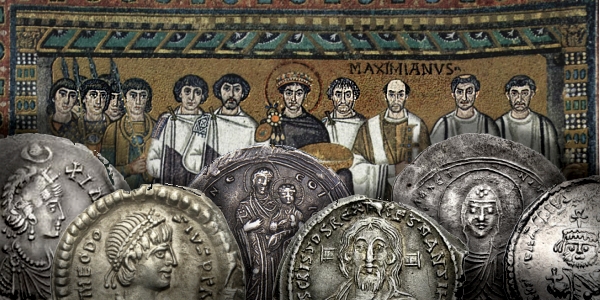
CoinWeek Ancient Coin Series by Mike Markowitz …..
The position of silver in the hierarchy of metals struck during the sixth century was a curious one. In the East, the currency in ordinary circulation consisted entirely of gold and copper. Though a number of silver coins of different types and modules have survived, they have usually done so only in twos or threes; several indeed are known only from unique specimens.[1]
-- Philip Grierson, Byzantine Coins (1982)
GOLD IS SCARCE. Silver? Not so much.
We expect silver coins to be more abundant and less valuable than gold ones. In the ancient world, the silver/gold ratio fluctuated within a fairly narrow band – between 10:1 and 14:1. But for the Eastern Roman Empire (which we call “Byzantine”), this assumption breaks down; paradoxically, gold is often common and silver is usually scarce, sometimes almost non-existent.
For example, the vast British Museum collection database reports only 112 hits for “coin, silver, Constantinople, AD 610-1000.” The American Numismatic Society’s (ANS) collection of some 13,000 Byzantine coins included only 289 examples of silver for the period AD 500-1000, and many of these are tiny fractional denominations from Western mints.
During the terrible third century AD (CE), the Roman economy experienced ruinous inflation and the currency was gradually debased, becoming mostly copper alloy with a trace of silver. At the beginning of the fourth century there was a recovery, with the return of a high-quality silver coin–the argenteus (issued 294-310)–at a weight of 96 to the Roman pound[2]. Over several decades, the standard shrank to 144 to the pound, but the metal remained quite good. It was probably still called an argenteus but modern numismatists call it a siliqua, after a small unit of weight that was the equivalent value in gold[3]. During the fourth century, the empire lost control over silver mines in Spain, Britain, and the Balkans. The rise of Christianity as the state religion “immobilized” tons of silver in the form of altar vessels and church fittings[4]. By the year 500, silver disappeared as part of the regular currency.
The Miliarense
With the high-value gold solidus (4.5 grams of nearly pure gold, introduced by Constantine I “the Great” in 312 CE) as the basis of the currency, alongside an ever-changing variety of low-value coppers, small change was a big problem[5]. Numismatists call these coppers “AE3” and “AE4”–we don’t know what their users called them. Imagine modern Americans facing a cash-only economy consisting mainly of hundred dollar bills at one end (with a few fifties and twenties,) and nickels, dimes and quarters at the other.
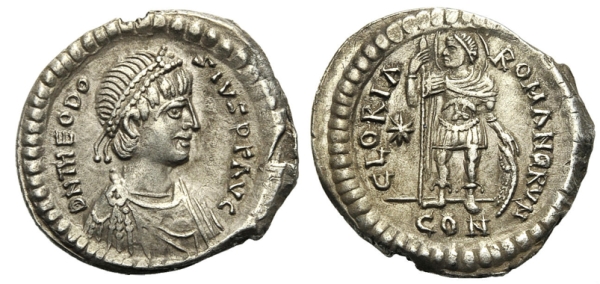
Theodosius II (408-450), Heavy Miliarense, Constantinopolis, AD 408-420; AR (g 4,33; mm 21; h 6); D N THEODO – SIVS P F AVG, diademed, draped and cuirassed bust r., Rv. GLORIA – ROMANORVM, emperor standing facing, holding spear and resting on shield; on l., star; in ex. CON. RIC 368; C 20.
As part of his currency reforms, Constantine introduced a fine silver coin called the miliarense (from the Latin miliarensis (meaning “of a thousand”), because a thousand of these coins roughly equaled the value of a pound of gold, a unit used to express large sums such as the salaries of officials). There were two versions: a “light” miliarense struck at 72 to the pound, and a “heavy” 60 to the pound. One gold solidus was worth 14 heavies or 18 lights.
Miliarenses were handsome, well-made coins, and many surviving specimens are pierced for wear as ornaments or amulets[6]. A typical obverse design was the emperor’s portrait, while the reverse often showed his standing figure in military garb, striking a noble pose and surrounded by the Latin motto GLORIA ROMANORUM (“Glory of the Romans.”)

Aelia Eudoxia, wife of Arcadius No.: 617 Light miliarense, Constantinople 400-404, AR 4.46 g. AEL EUDO – XIA AVG Diademed and draped bust r., wearing earring and necklace; crowned above by the Hand of God. Rev. The Empress seated on throne facing, wearing diadem (?) and mantle, crowned above by the Hand of God; at sides, two crosses. In exergue, CON. C –. RIC –. LRC –. Apparently unique and unpublished. Good very fine
The rarest fifth century silver was struck for empresses. For Aelia Eudoxia, wife of Arcadius (Byzantine Emperor 395-408), a light miliarense shows the elaborate helmet-like hairdo favored by imperial ladies of this era. On the reverse she sits enthroned, flanked by plain crosses, while the “hand of God” reaches down to crown her. Aelia Eudocia (the similar names are an endless source of confusion), wife of Theodosius II, appears similarly coiffed on a rare silver siliqua of Constantinople, but the reverse is simply a cross in a wreath.
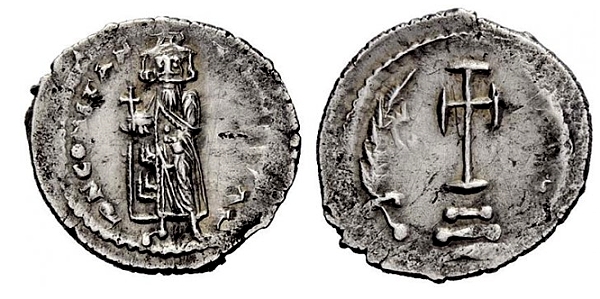
Constans II 641 – 668 Half miliarensis 652-654, AR 2.19 g. δ N CONStAN – [tINYS PP AV] Emperor standing facing, wearing chlamys and crown with cross, holding globus cruciger. Rev. Cross potent on two steps between two palm branches.
“Ceremonial” Silver
When numismatists describe a coin as “ceremonial,” what we mean is “we don’t know what this thing was.” A long series of rare, crudely struck silver coins of irregular weight (nominally 144 to the pound, or about 2.2 grams) are catalogued as “ceremonial.” They depict the ruler on the obverse and a cross on steps flanked by palm branches on the reverse. One theory is that they were thrown to the crowd at imperial celebrations. The palm branches might be associated with Palm Sunday (the Sunday before Easter commemorating Jesus’ triumphal entry into Jerusalem[7]). The palm branch was also a pagan symbol of victory.
The Hexagram
At the beginning of the seventh century, the Empire was in deep, deep trouble. When Heraclius overthrew the tyrannical Phocas (602 – 610), the frontiers were collapsing and the treasury was nearly empty. In 614 the Persians captured Jerusalem, seizing the most precious relic of the Orthodox Church: the True Cross, supposedly discovered by St. Helena, mother of Constantine the Great, in 326 CE. The Persians soon occupied Egypt, the empire’s richest province.

Heraclius, with Heraclius Constantine. 610-641. AR Hexagram (23mm, 6.04 g, 7h). Constantinople mint. Struck circa 615-630. Heraclius and Heraclius Constantine seated facing on double throne, each holding globus cruciger; cross above / Cross potent on globe set on three steps. DOC 61; MIB 134; Yannopoulos Class 1;
Short of gold to pay both his troops and imperial officials, in 615 Heraclius introduced an emergency silver coin, the hexagram. Struck at a standard of 48 to the pound (6.8 grams), and valued at 12 to the gold solidus, the coin bore the image of Heraclius and his infant son Heraclius Constantine enthroned side by side. Over the next 23 years, the son gradually gets bigger and bigger and is eventually bearded. The reverse bore a cross over a globe above three steps, with the Latin invocation DEUS ADIUTA ROMANIS (“O God, Assist the Romans.”) A very rare half-hexagram is known from only two examples. A few hexagrams were struck at Ravenna in Italy, but the coin never caught on in the western provinces, where tiny silver coins like the “quarter siliqua” were preferred.
A new design appeared in 638 when a second son, Heraclonas, was crowned as co-emperor. Considerably rarer (only issued for three years), it shows the three rulers standing together.

Hexagram 692-695, AR 6.64 g. IhSCRIStDSREX – RESNANtIYM Bust of Christ facing, with cross behind head; wearing pallium over colobium, with r. hand raised in benediction and l. holding book of Gospels. Rev. DIYStINIANYS – SERYSChIStI Δ Justinian, wearing crown and loros, standing facing, holding cross potent set on two steps, and akakia; beneath, CONOB. DO 17. MIB 40. Sear 1259
Heraclius’s grandson Constans II (641-668) issued a large volume of hexagrams, many struck on irregular flans that appear to be cut with chisels or shears. These are the most common and affordable examples today. Production tapered off under Constans II’s son, Constantine IV (668-685). Under another son, Justinian II (685-695; 705-711), only a few “ceremonial” hexagrams were struck from dies used for gold solidi.
The Miliaresion
The disappearance of the hexagram left a wide gap in the structure of the currency. Some time after 720, Emperor Leo III introduced a new lightweight silver piece, the miliaresion, which would remain in use for over three centuries.
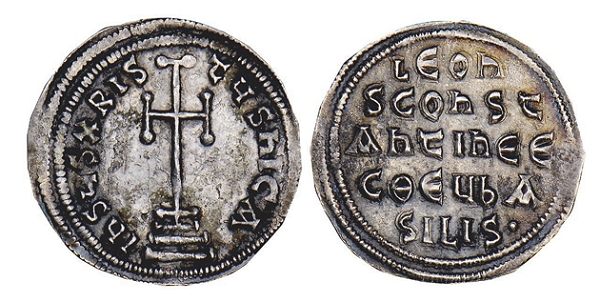
Leo III, 717-741 with Constantine V. Miliaresion, 735-741. HiSys HRISTYS Nicas Cross potent on three steps; triple border Rv. LEON C CONSTANTINE EC QEU bASILIS in a triple border. g. Sear 1512
Weighing about 2.25 grams, it was struck at a standard of 144 to the pound. It resembled the heavier contemporary dirhem of the Muslim Umayyad Caliphate (about 2.9 grams.) Many are actually struck on cut down Islamic silver coins obtained either through trade, received as tribute or captured as booty. The obverse of the miliaresion bears a cross on steps[8] surrounded by the defiant Greek inscription, “Jesus Christ Conquers.” The reverse inscription is “Leo and Constantine, in God, Emperors.” A generation later, another Emperor Leo (the Fourth) with another son named Constantine (the Sixth) used the identical inscription. The only difference is the shape of the cross: tall and thin with long crossbars for Leo III, and wide with short cross bars for Leo IV (which is considerably more scarce.) These coins are often confused and mis-attributed.
The prosperous reign of Emperor Theofilos (829 – 842) saw an increase in the miliaresion’s weight to about 3 grams (108 to the pound). Reverse inscriptions became longer and were often sharply engraved in a handsome mix of Greek and Latin letterforms.

Constantine VI & Irene. 780-797. AR Miliaresion (22mm, 2.27 g, 1h). Constantinople mint. Cross potent on three steps / Legend in five lines. DOC III 4a; SB 1595. VF, toned. Overstruck on an Umayyad dirhem.
Perhaps the most beautiful Byzantine silver coin is the rare miliaresion of Romanos III (1028-1034). The obverse is based on the Hodegetria – a famous icon of the Mother of God with the infant Christ. The reverse shows the standing emperor holding imperial regalia, a staff, and orb. The poetic Greek inscription begins on the obverse and continues on the reverse: “He who places his hope in Thee, O Virgin, will prosper in all he does.” The reverse of this coin was imitated on a Danish silver coin of King Sweyn Estridson (ruled 1047-1074). Danish Vikings served in the Byzantine emperor’s imperial guard and brought their pay home with them.
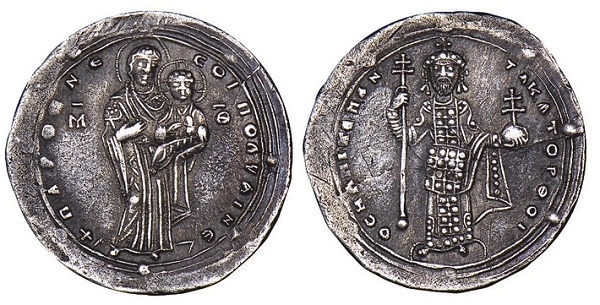
Romanus III Argyrus (1028-1034). Miliaresion. Constantinople, 1030. + ΠAPΘЄNЄ COIΠO ΛVAI NЄ. The Theotokos nimbate, wearing CHITON decorated with diamond of four pellets and maphorium, standing on dais, with r. hand on breast and on l. arm holds the Christ-child, raising r. hand in benediction and holding scroll in l.; in field l. and r., M and Θ. Rv. OC HΛΠ I KЄ ΠANTA KATOPΘOI. Romanus bearded, wearing loros and crown with pendilia, standing facing on round cushion, holding long patriarchal cross and globe surmounted by patriarchal cross on •; triple linear border with eight globules. AR 2.78 grams, 6h. DOC (3b); Sear 1822. Extremely rare.
In the 11th century, fractional denominations appear.
Constantine IX (1042-1055) introduced a two-thirds miliaresion weighing a bit more than 2 grams and Constantine X (1059-1067) introduced a one-third miliaresion weighing less than a gram. These usually carry the image of Christ or the Virgin and all are quite rare, especially in good condition.
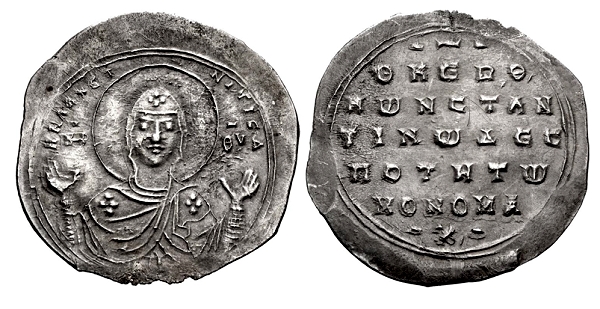
CONSTANTINE IX, Monomachus. 1042-1055. AR Two-Thirds Miliaresion (2.16 gm, 6h). Constantinople mint. H RLAXEP NITICA, MHP QV across fields, facing bust of the Virgin orans, nimbate, wearing tunic and maphorion / – — -QKER, Q, KWNCTAN TINW DEC POTH TW MONOMA -X,- in six lines. DOC III 8a; BN 8; SB 1835.
Most surviving miliaresia are clipped, and many are pierced. The coin was so thin it tended to crack or chip around the edges, especially in later years when the alloy was debased.
In 1092 the Emperor Alexios I launched a comprehensive reform of the currency, with a complex mixture of gold-silver (“electrum”) and silver-copper (“billon”) alloy denominations.
Relatively pure silver Byzantine coinage would return in the 13th century, influenced by the growing importance of the Venetian grosso as a trade coin. But that is a story for another day…
Collecting Byzantine Silver
Byzantine silver is a challenge for collectors. A few common types can be found for under US$100, but scarce types in high grades may only appear on the market once or twice a decade, and competition can be fierce, with prices in the thousands, or (recently) tens of thousands.
I analyzed two major Byzantine auctions: Sotheby’s 1990 sale of the W. H. Hunt collection, and Stack’s 2009 sale of a private collection. In the Hunt sale, out of 864 coins from our period of interest (491-1092), only 86 were silver (10%). In the Stack’s sale, out of 231 coins from the same years, only 20 were silver (8.6%).
The standard reference for Byzantine coinage is the massive and costly Dumbarton Oaks Catalogue (1966 – 1999, commonly abbreviated as “DOC”) in five volumes. David Sear’s Byzantine Coins and Their Values (1987) is affordable, and essential to the serious collector, but becoming outdated.
The only book about hexagrams, Yannopoulos (1978) in French, is hard to find.
* * *
Notes
[1] Grierson. 96.
[2] The libra or Roman pound of 12 ounces was theoretically 328.9 grams, but in practice was a bit less. Our abbreviation “lb.” for pound comes from the Latin word.
[3] A siliqua was the weight of one seed of the carob tree (Ceratonia siliqua) – 0.19 gram. Under the name “carat” this unit is still used for gemstones.
[4] Famous examples that survive include the Kaper Koraon treasure and the Attarouthi treasure.
[5] Sargent and Velde (1999) give a rigorous economic analysis of this problem based on historical evidence.
[6] Of course this reduces their value to collectors. I was taught “never buy a pierced coin, because it will be impossible to sell.” I have violated this rule twice, for pieces so rare I would never be able to afford an unpierced specimen.
[7] Matthew 21:1–11, Mark 11:1–11, Luke 19:28–44 John 12:12–19
[8] In heraldry — and numismatics — a cross with short crossbars at the ends of the arms is called a cross potent.
References
Bellinger, A. and Philip Grierson (eds.) Catalogue of the Byzantine Coins in the Dumbarton Oaks Collection and in the Whittemore Collection. 5 vols. Washington (1966-99)
Grierson, Philip. Byzantine Coins. Berkeley (1982)
Hendy, Michael. Studies in the Byzantine Monetary Economy c.300 – 1450. Cambridge (1985)
Hendy, Michael. Coinage and Money in the Byzantine Economy 1081-1261. Dumbarton Oaks. (1969)
Miles, George. “Byzantine Miliaresion and Arab Dirhem: Some Notes on Their Relationship.” ANS Museum Notes 9 (1960)
Sargent, Thomas J. and François R. Velde. “The Big Problem of Small Change.” Journal of Money, Credit and Banking 31 (1999)
Sayles, Wayne. Ancient Coin Collecting V: The Romaion/Byzantine Culture. Krause. (1998)
Sotheby’s. The William Herbert Hunt Collection: Highly Important Byzantine Coins. (5-6 December 1990)
Stack’s. Moneta Imperii Romani Byzantini (12 January 2009)
Sear, David R. Byzantine Coins and Their Values. 2nd edition. Seaby (1987)
Yannopoulos, Panayotis. L’Hexagramme. Louvain. (1978)
* * *
 Mike Markowitz is a member of the Ancient Numismatic Society of Washington. He has been a serious collector of ancient coins since 1993. He is a wargame designer, historian, and defense analyst. He has degrees in History from the University of Rochester, New York and Social Ecology from the University of California, Irvine. Born in New York City, he lives in Fairfax, Virginia.”
Mike Markowitz is a member of the Ancient Numismatic Society of Washington. He has been a serious collector of ancient coins since 1993. He is a wargame designer, historian, and defense analyst. He has degrees in History from the University of Rochester, New York and Social Ecology from the University of California, Irvine. Born in New York City, he lives in Fairfax, Virginia.”





A very well written and informative article. The pieces
shown are some of the nicest examples outside of
major museum or personal collections. The Hexagram 692-695,
Theodosius II and Romanus III are especially choice.
Well done!!